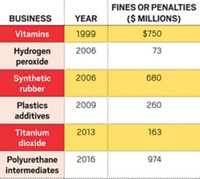Advertisement
Grab your lab coat. Let's get started
Welcome!
Welcome!
Create an account below to get 6 C&EN articles per month, receive newsletters and more - all free.
It seems this is your first time logging in online. Please enter the following information to continue.
As an ACS member you automatically get access to this site. All we need is few more details to create your reading experience.
Not you? Sign in with a different account.
Not you? Sign in with a different account.
ERROR 1
ERROR 1
ERROR 2
ERROR 2
ERROR 2
ERROR 2
ERROR 2
Password and Confirm password must match.
If you have an ACS member number, please enter it here so we can link this account to your membership. (optional)
ERROR 2
ACS values your privacy. By submitting your information, you are gaining access to C&EN and subscribing to our weekly newsletter. We use the information you provide to make your reading experience better, and we will never sell your data to third party members.
Business
Having The Mettle For Sodium Markets
Métaux Spéciaux and DuPont compete head-to-head in sodium metal
by Ann M. Thayer
October 27, 2008
| A version of this story appeared in
Volume 86, Issue 43

"SODIUM IS a small world," says Frédéric Chaminant, sales director of France's Métaux Spéciaux SA, the world's largest sodium metal producer. Global demand of 80,000 to 90,000 metric tons per year is supplied entirely by MSSA, DuPont, and three Chinese companies. But despite what might appear to be a cozy marketplace, the two Western firms are accusing each other of dumping sodium by selling it at cut-rate prices in a business worth roughly $180 million.
Sodium metal is valued as a powerful reducing agent, yet it is so highly reactive that it doesn't occur naturally in its pure form. Instead, the soft metal is made through the capital- and energy-intensive electrolysis of molten sodium chloride.
MSSA's facility in the French Alps taps into hydroelectric power, as does DuPont's in Niagara Falls, N.Y. MSSA's production capacity is 27,000 metric tons, Chaminant says, and he estimates that DuPont's is a few thousand tons less. MSSA ships the hard-to-handle metal in ingots, containers, and railcars, as well as by pipeline, whereas DuPont supplies bulk forms and imports ingots from China.
In its heyday, sodium was made by several companies that supplied producers—including DuPont—of tetraethyl lead, the air-polluting gasoline additive that was phased out in the U.S. in 1986. Sodium demand declined further in the 1990s, when titanium producers moved to cheaper reducing agents as a response to increased competition from Russian titanium entering the market. But many specialty chemical and purified metal makers still use sodium as an intermediate in manufacturing.
"We reached the bottom of the market about two years ago and are now on a growth curve," Chaminant says. "New applications with rapid growth are developing." Applications that call for sodium include polysilicon production for photovoltaics, new lower cost processes for making titanium for military vehicles and aircraft, and sodium methylate catalysts for biodiesel synthesis (C&EN, Aug. 25, page 20).
In two or three years, Chaminant expects the sodium market to grow to between 100,000 and 120,000 metric tons per year. Declining tax incentives, rising energy costs, and quality concerns are limiting Chinese sodium exports, leaving MSSA and DuPont as the main global suppliers. MSSA also is the only producer of highly purified sodium used as a coolant for fast-breeder nuclear reactors.
MSSA exports most of its product. U.S. imports of sodium from France have been rising, nearly doubling between 2005 and 2006. The average import price in recent years has been between 91 and 95 cents per lb, according to the U.S. International Trade Commission (ITC), compared with about $1.06 per lb in 2004.
DuPont lodged a complaint with U.S. trade authorities in late 2007, alleging that French imports were being sold at less than fair market value relative to the cost of production. On Oct. 14, the U.S. Department of Commerce levied an antidumping duty of 66.6% on sodium imports from France. An ongoing ITC investigation will determine whether these imports injure the domestic sodium industry—that is to say, DuPont.
DuPont declined to be interviewed by C&EN, but the company has made its position clear in recent trade hearings and briefs. "Imports of sodium metal from France have already had an adverse impact on DuPont's production, shipments, and sales," testified Kenneth J. Hilk, DuPont's business and marketing manager for reactive metals, in late 2007. DuPont has been unable to raise prices to offset raw material, energy, and labor costs and as a result has seen its business lose money, he said. MSSA's aggressive actions since 2003, a lawyer for DuPont added, have led to a "precipitous decrease in DuPont's market share."
DuPont's problems are its own, MSSA maintains, and are not due to the French firm's sales or pricing strategies. According to Chaminant, DuPont uses much of its sodium output itself for making biodiesel catalysts or sells it at a contracted price to Rohm and Haas, its largest customer, for producing sodium borohydride and other chemicals. In 2006, DuPont lost its second largest customer, Syngenta, which changed its sodium-using paraquat herbicide manufacturing process and moved production to China.
Meanwhile, MSSA's largest U.S. customer is the polysilicon producer MEMC, which it serves from a loading facility built in 2004 in Texas. MEMC has also been a DuPont customer.
The two Western firms accuse each other of dumping sodium by selling it at cut-rate prices.
Because sodium plants can't easily be stopped or started, producers rely on contracts and careful, long-term supply-and-demand planning with customers. "Sodium isn't a commodity, and this isn't a spot market," Chaminant says.
For the ITC investigation, MSSA and DuPont have identified 71 U.S. purchasers of sodium. Of the 38 firms that replied to an ITC questionnaire, the top 10 accounted for 94% of reported purchases. About half of the 38 bought only from MSSA, with the rest evenly divided between buying from DuPont or from both companies.
MSSA doesn't deny that it has gained market share at DuPont's expense, but it credits quality, product form, and logistics rather than price. Sodium is generally produced in different grades that vary by purity and the amount of residual calcium. Some customer feedback offered to ITC indicates that DuPont's material causes operating and safety problems that don't occur with MSSA's Sopure grade, which has less than 200 ppm of calcium.
DuPont argues, however, that French and U.S. technical grades of sodium, which are about 99.8% pure and have less than or equal to 400 ppm of calcium, are perceived as interchangeable. DuPont also contends that calcium buildup and plugging can occur with commercial-quality material regardless of the source.
"WITH FEW rare exceptions, the purity level of sodium metal does not materially affect the end-use application," Hilk testified. "Every U.S. customer who is now purchasing sodium metal from M??taux has, at some time in the past, purchased their requirements from DuPont."
DuPont characterizes the sodium business as a mature one in which price is the single largest factor influencing purchasing decisions. The company points out that MSSA's purer Sopure product, which has accounted for nearly 90% of MSSA's growth in the U.S. market, would be expected to command a price premium but hasn't.
MSSA introduced its Sopure grade with "a limited or no premium, so customers would try it out," Chaminant says, with the result that the improved performance made it "the new standard" for customers. Beyond quality, some sodium purchasers told ITC that they purchase MSSA sodium to have a second supplier or to avoid buying from DuPont because some of these purchasers compete in downstream markets such as sodium methylate.
Chaminant claims that where the firms do compete, MSSA's prices are generally higher than DuPont's. To illustrate this, he points to ITC data that show French imports underselling domestic product in just three of 12 quarters. MSSA believes DuPont's contracted price to Rohm and Haas has limited DuPont's flexibility in raising prices and is also much lower than MSSA's prices to its own customers.
Although Chaminant says he'd rather compete in the marketplace, MSSA has launched a regulatory counterattack. In August, at the company's behest, the European Commission began two trade investigations of DuPont. "We believe DuPont is selling sodium in Europe at lower than market prices and is receiving unfair subsidies for electricity," Chaminant says. MSSA claims DuPont's prices are 25–35% lower than those DuPont charges in the U.S. and that it gets subsidies from the State of New York of 30–40%. As a result, MSSA says it has lost up to 35% market share in Europe during the past five years as DuPont exports from the U.S. have increased.
The EC won't make its preliminary determination until April 2009, whereas ITC should reach a final decision by late November. In its preliminary decision in 2007, ITC indicated that it lacked "reliable information either affirming or negating significant adverse price effects" and was therefore unable to draw a conclusion that there was no injury from French imports. Nevertheless, with ITC Chairman Daniel R. Pearson dissenting, the commission found that the industry in the U.S. is experiencing material injury and that it would move ahead to a final investigation.
U.S. trade officials, meanwhile, have been collecting the antidumping duty on MSSA imports. That additional cost has been passed on to customers, Chaminant says, "but we haven't lost one customer due to the increased price."






Join the conversation
Contact the reporter
Submit a Letter to the Editor for publication
Engage with us on Twitter